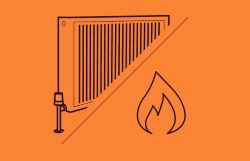Record high LNG deliveries as fears Europe may run out of gas this year.
European demand for LNG (liquefied natural gas) is reaching record highs, with worries that some nations could run out of gas in the winter. The amount of LNG transported through the European gas transmission system has seen the highest levels since 2011.
As of January 28th, 405 million cubic meters of gas was delivered to Europe, 110% higher in comparison to the annual average over the last five years. In European gas storage tanks, LNG stocks are also 5% above the five-year average.
But what is LNG? What is it used for? Why is there such a demand for it?
This article will help to explain the LNG crisis that is sweeping Europe and look at what is going on in the UK.
What Is LNG?
LNG, short for liquefied natural gas, is made over the duration of millions of years. It is the transformation of organic materials, including plankton and algae. Usually, gas is located far from gas fields, so the process is costly and impractical.
LNG solves this problem, as the gas is cooled to create a liquid, shrinking in volume to then be stored and shipped more easily and safer. It is a clear and non-toxic liquid that is formed when natural gas is cooled to -162ºC (-260ºF).
This cooling process will shrink the volume of the gas by 600 times smaller making it easy to transport. It will not ignite when it is in its liquid state making it safer, then when reaching its destination, it will be turned back to gas, then used to supply power to homes, businesses and industries.
What Is LNG Used For?
Once LNG is returned to a gas, it will be warmed to become natural gas. We use natural gas for many different reasons, such as heating homes and businesses, cooking and manufacturing products like fertilisers and medicines.
What Is The Current LNG Situation?
With record highs of LNG running from entry terminals to the European gas transmission systems, there has been a huge 110% increase when compared to the annual average for this date over the past five years.
Starting in the US and ending in Europe, over two-dozen tankers equipped with LNG, along with a further 33 ships were deployed to help out.
Wholesale gas prices have been soaring across the world, especially in Europe. There are many different reasons that have all combined to create the European energy crunch we are currently facing.
For consumers in the UK, many have been looking for the cheapest energy deals on the market. Price cap warnings and soaring energy bulls have crept into many households.
One of the biggest factors was storage tanks located in Europe dropping to the lowest levels seen in over ten years. In addition, maintenance at Norwegian fields has taken much longer than anticipated, as well as Russia restocking its own inventories.
European gas reserves in underground storage facilities fell to 39.22% on January 27th, 5.6% less than the annual average for this date over the past five years. Currently, this equates to 15.7 billion cubic meters less than in 2021.
Furthermore, the conflict between Ukraine and Russia has sparked concerns regarding Russian gas supplies. With both the United States and other nations pledging to impose anti-Russian sanctions in the event of an invasion, Russian energy sales may be targeted.
There are suggestions that Europe will be able to manage this year’s heating season, with just enough gas to supply homes. However, it will be a close call, with sudden changes in the weather meaning Europe is vulnerable to demand swings.
Deliveries from Russia have been reduced, with Gazprom fulfilling their contract with Ukraine. This supply of 40bn cubic metres of gas using Ukraine’s pipeline network has been completed, however, extra capacity has not been booked since.
The other main route that Russia uses is the Yamal-Europe pipeline, running from Poland to Germany. This was recently in reverse flow mode, transporting gas back to Russia.
Gazprom announced that they would not be delivering any more gas via Yamal-Europe, as customers, the main consumers being Germany and France.
More price pressures have complied as Bloomberg reported that some of Gazprom’s customers were not being sent any more gas to those who had reached the full capacity of gas delivery under their long-term contracts.
What About LNG And The United States?
The United States saw exports of LNG reaching record highs in December due to high European demand. The records were reflected in the rise in demand for home heating and industrial fuel, pushing prices to new levels in Asia and Europe.
With the United States having large quantities and cheap supplies, the nations shale oil and gas industry has soared over the last 10 years, seeing domestic production exceeding U.S. demand by about 10%.
Around 7.15 million tonnes of LNG was exported just last month, shipped away on 106 vessels. This sees a 16% increase when compared to just one year ago when 6.14 million tonnes was shipped on 89 vessels in the same month.
However, this month two LNG ships that were bound for Europe have been re-routed. One of them heading for Asia due to the price differential. If demand rises in Asia, further diversions to Europe will be halted.
LNG prices are currently higher in Asia than in Europe, meaning flows could shift if temperatures drop. The market is volatile and demand will vary depending on multiple factors.
In Belgium, the UK and the Netherlands, 30 LNG tankers are scheduled for delivery this month. 13 of these will be arriving from the United States.
Once the supply reaches the shores of the UK, consumers may face the rising energy costs added to their energy bills. For those looking to save money, there are methods of instantly calculating your electricity bill online. This is one of the quickest and easiest ways to save energy.
Meanwhile, in the United States, the nation has huge quantities of natural gas. On the other hand, processing and chilling capacities are limited, meaning that LNG export plants are reaching the maximum processing capacity.
Last year, no LNG processing plants were approved in the United States, however, almost a dozen plants proposed are awaiting financial commitments over the past few years.
Due to trade tensions between China and the United States, spending on LNG projects dropped, as well as gas prices fell during the COVID-19 pandemic.
What About Russia And LNG?
Tensions between top gas supplier Russia and Ukraine is causing increasing impacts on the price of natural gas in Europe. Fluctuations in demand and shipments remaining below normal are causing other nations to panic.
Gas sent through Ukraine via Velke Kapusany, the major entry point in Slovakia saw levels rise to the higher since Jan. 1. In Amsterdam, prices dropped as much as 7.1%, with contracts closing 18% higher on Monday. In the UK, contracts gained 1% to 227 pence a therm.
Conflicts with Ukraine has caused energy traders to carefully watch for signs of Russia bringing some relief to the tight European gas market.
There could be a potential reduction in the gas flow to Europe from Russia, dangerous during a time when storage is extremely low and winter demand remains high.
Western allies are trying to use diplomatic efforts to avoid war, with Russian troops marching towards Ukraine’s borders. The United States has placed a high alert to 8,500 troops for deployment if needed.
In addition, one of the world’s biggest exporters of liquefied natural gas, Qatar, couldn’t increase production and transportation of natural gas to Europe in the event of any disruption to Russian flows.
What Would War Between Russia And Ukraine Mean for Europe’s Energy?
If Russia does invade Ukraine, then oil and gas markets will remain tight. There is a clear and present threat due to the current shortage of gas and low storage levels being depleted.
We may see significantly higher oil and gas prices, all at a time when Europe is still reeling from the recent energy crisis, reviving relief in the form of liquefied natural gas shipments.
Shipments being diverted to Asia shows that signal flows could weaken. Asia is showing high demand, as well as expected rises in temperature across mainland Europe next week.
Within the coming weeks, gas demand for power generation could ease thanks to the forecasted potential of high wind power output across the continent.
The long-standing dependence on Russian gas across Europe shows how much danger these tensions are for European countries. Limits in shipments from Qatar and the United States, as well as the challenges to meet climate goals, are real problems.
Energy suppliers in the UK are looking to use renewable fuel sources and try to meet their green goals. This list of energy suppliers can help to show you which ones are green efficient, as well as which ones will bring you the best deal.
Recently, some European nations have even been looking to use coal and oil as emergency fuels.
Since the 1970s, the Soviet Union has been supplying Europe with natural gas, with Russia now providing as much as 40 per cent of the natural gas needs of the continent. However, the majority of the gas been supplied under long-term contracts.
As a result, European natural gas prices continue to soar to six or seven times their usual levels. When Russia holds back supplies of natural gas, stored levels of the gas reach their lowest volumes. This is the buffer that is used when energy supplies are challenging.
So, even when we take out disruptions, the next three months will be a huge task. Supplies will be extremely tight and we will likely be facing a long winter.




